-
Urbanization and the Global Climate Dilemma
›
Urbanization and climate change may be the two most important trends to shape global development in the decades ahead. On the one hand, urban cities have the potential to serve as engines of change, driving economic growth in some of the world’s least developed countries and pulling more people out of poverty than at any other time in history. On the other hand, climate change could undercut all of this by exacerbating resource scarcity and putting vulnerable communities at risk from sea level rise and more frequent and intense storms.
-
Budgeting for Climate
› Update: Read a response by Miriam Pemberton
Update: Read a response by Miriam Pemberton“The Obama administration…has identified the task of substantially reducing greenhouse gas emissions as one of its top priorities,” writes Miriam Pemberton in a new report from the Institute for Policy Studies, “Military vs. Climate Security: Mapping the Shift from the Bush Years to the Obama Era.”
-
In Dealing with Climate Change, A Role for Global Governance
›April 14, 2009 // By Will Rogers “The idea of being a citizen of the world is still controversial,” said Strobe Talbott at a March 12, 2009, event examining the “great experiment” of global governance. Nevertheless, Talbott, president of The Brookings Institution, argued that global governance will be key to solving three of the greatest challenges the world faces: nuclear proliferation, climate change, and the financial crisis. This event was co-sponsored by the Wilson Center’s Environmental Change and Security Program and the Environmental Film Festival in the Nation’s Capital.
“The idea of being a citizen of the world is still controversial,” said Strobe Talbott at a March 12, 2009, event examining the “great experiment” of global governance. Nevertheless, Talbott, president of The Brookings Institution, argued that global governance will be key to solving three of the greatest challenges the world faces: nuclear proliferation, climate change, and the financial crisis. This event was co-sponsored by the Wilson Center’s Environmental Change and Security Program and the Environmental Film Festival in the Nation’s Capital.
From Imperialism to Internationalism: The “Great Experiment” of Global Governance
“Bad news has often been the mother of good news” in the long history of global governance, Talbott said. Imperialism “brought fractious tribes and cultures together under a single authority—an attempt at global governance that ultimately failed.”
In the wake of World War I’s destruction came the League of Nations, a stab at global governance that lacked American support and “failed abysmally at preventing the Second World War,” Talbott noted. World War II spawned the United Nations, which was more successful due to the United States’ participation and influence.
From the ashes of the Cold War rose a more interconnected Europe, which Talbott affectionately referred to as the “Euro-mess”—a “system in which multiple countries make common cause in the face of common challenges,” he said. “Part of what we must hope for in the years ahead is the emergence of a more robust ‘globo-mess’—the creation and strengthening of regional and global organizations.”
Global Governance for Global Challenges
According to Talbott, the nuclear arms control treaties exemplify effective global governance in the pursuit of the ultimate common goal: the survival of the human race. “We need to build on past experiences and existing institutions to address challenges like climate change and financial regulation,” he said.
Talbott suggested that we use the existing nuclear nonproliferation regime to build an effective climate control system that ensures that “civilian nuclear power—which we are going to be seeing a lot more of—will be safe and confined to peaceful purposes.”
Similarly, a global financial regime could help bolster the effectiveness of a climate regime by stabilizing the world’s credit markets, enabling them to help “finance commercially viable technologies to end our dependence on fossil fuel,” Talbott said. “If we’re going to have efficient, equitable markets in which to trade in carbon allotments,” we will need a robust global economic regime, as well, he said.
With global governance, “progress has almost always been reactive. But in dealing with climate change, progress needs to be proactive,” as when the world has come together to prevent nuclear war, Talbott said. “If we fail to recognize our own obligations as citizens of the world,” he warned, “we risk, if not our own lives, then the lives of our children and their children.”Photo: Strobe Talbott. Courtesy of Dave Hawxhurst and the Woodrow Wilson Center.
-
From Assessment to Intervention: Redefining UNEP’s Role in Conflict Resolution
›April 9, 2009 // By Will Rogers “Can we get beyond the point where environment and conflict always has to be a story of tragedy with no happy ending?” asked Achim Steiner at the March 24, 2009, launch of From Conflict to Peacebuilding: The Role of Natural Resources and the Environment, a new report from the UN Environment Programme (UNEP).
“Can we get beyond the point where environment and conflict always has to be a story of tragedy with no happy ending?” asked Achim Steiner at the March 24, 2009, launch of From Conflict to Peacebuilding: The Role of Natural Resources and the Environment, a new report from the UN Environment Programme (UNEP).
“I think we actually can provide a critical set of building blocks that would allow us to be not just lamenters on the sidelines,” but active problem-solvers, said Steiner, UNEP’s executive director. UNEP would like to put “green advisers, so to speak, with blue helmets” to examine peacebuilding “from an environmental, natural resource restoration point of view” and “minimize the potential for conflicts to escalate again,” said Steiner, who recently met with Alain Le Roy, UN undersecretary-general for peacekeeping operations, to discuss plans for embedding environmental advisers with UN peacekeeping troops.
Steiner was joined by Daniel Reifsnyder, deputy assistant secretary for environment at the U.S. State Department, and Andrew Morton, manager of UNEP’s Disasters and Conflicts Programme, to discuss the report’s findings.
Natural Resources and the Conflict Continuum
According to From Conflict to Peacebuilding:- Forty percent of intrastate conflicts within the past 60 years have been strongly linked to natural resources.
- Such conflicts are twice as likely to relapse within the first five years of peace.
- Less than a quarter of peace agreements for these conflicts address natural-resource issues.
Environmental factors can contribute to conflict and subvert peace in three main ways:
- The inequitable distribution of resource wealth, competition for scarce or valuable resources, and environmental degradation can contribute to the outbreak of conflict.
- Natural resources can used as “a financing vehicle for conflict—sustaining conflict well beyond the point where conflict has its origin, to actually having become part of an at-war economy, a conflict economy,” Steiner said.
- Unresolved environmental issues can subvert peace negotiations, especially when warring parties have a stake in lucrative resources. If we do not understand “how environment and natural resources can undermine very volatile peace agreements,” Steiner warned, we can “find ourselves back where we started off from.”
Lessons Learned and the Way Forward
Natural-resource conflicts have direct impacts—like deforestation and desertification—and indirect impacts—like the disruption of livelihoods—that are devastating to communities, Morton said. They also weaken a government’s capacity to manage its industry and infrastructure, like waste management and water purification, creating new environmental problems—and thus possible future conflict.
But the environment also offers opportunities, Morton emphasized. In Rwanda, for instance, “we have gorilla tourism going on within a few kilometers of what, essentially, was a war zone.”
UNEP recommends that peacekeepers:- Assess the natural-resource and environmental issues underlying conflicts.
- Monitor and address natural-resource use in conflict areas.
- Incorporate resource-sharing agreements into peace deals.
- When cooperation is not possible, use punitive measures to end resource exploitation.
U.S.-UNEP Cooperation on Environment, Peacebuilding According to Reifsnyder, the U.S. government frequently supports UNEP initiatives, such as the $1.8 million in U.S. funding for a UNEP reforestation and energy-efficiency program in an internally displaced persons camp in Darfur. This project grew out of the post-conflict environmental assessment that UNEP recently conducted in Sudan.
According to Reifsnyder, the U.S. government frequently supports UNEP initiatives, such as the $1.8 million in U.S. funding for a UNEP reforestation and energy-efficiency program in an internally displaced persons camp in Darfur. This project grew out of the post-conflict environmental assessment that UNEP recently conducted in Sudan.
Reifsnyder praised UNEP’s focus: “UNEP is uniquely positioned to play a real catalytic role within the UN system, bringing together various parts of the UN system to try to focus on the importance of natural resources and the importance of the environment in peacebuilding initiatives,” he said.
Photos: From top to bottom, Achim Steiner, Andrew Morton, and Daniel Reifsnyder. Courtesy of Dave Hawxhurst and the Woodrow Wilson Center. -
Grassroots Efforts Help Achieve Population, Health, and Environment Goals in Nepal
›April 1, 2009 // By Will Rogers “If you want to bring about conservation of these big, iconic species that need lots of area to roam, you have to work with the people that are living there,” said Jon Miceler at a March 19, 2009, event, “Population, Health, and Environment in Nepal.” Miceler, managing director for the World Wildlife Fund’s (WWF) Eastern Himalayas program, and Rishi Bastakoti, director and co-founder of Resource Identification and Management Society Nepal (RIMS Nepal), discussed their ongoing work on population, health, and environment (PHE) programs in Nepal.
“If you want to bring about conservation of these big, iconic species that need lots of area to roam, you have to work with the people that are living there,” said Jon Miceler at a March 19, 2009, event, “Population, Health, and Environment in Nepal.” Miceler, managing director for the World Wildlife Fund’s (WWF) Eastern Himalayas program, and Rishi Bastakoti, director and co-founder of Resource Identification and Management Society Nepal (RIMS Nepal), discussed their ongoing work on population, health, and environment (PHE) programs in Nepal.
Protecting Tigers in the Terai
To protect endangered Bengal tigers in Nepal, WWF seeks to simultaneously protect the ecosystem and support sustainable livelihoods in the Terai Arc Landscape (TAL), a biodiverse region that spans the India-Nepal border. Environmental threats to the Terai include:- Conversion of forest into farmland;
- Overgrazing;
- Forest fires;
- Excessive extraction of timber and fuelwood;
- Poaching;
- Human-wildlife conflict; and
- Population growth.
“By protecting a tiger—which is what we call an ‘umbrella species’—you’re actually protecting a whole host of species below that, and a whole host of ecosystems that are connected with the tigers,” said Miceler.
Piloting PHE in Khata
In the Khata corridor, a region of the TAL, WWF worked with local leaders and community forest user groups to create a “permanent community-managed health clinic with basic clinical tools,” Miceler said. In addition, the program:- Distributed 172 arsenic filters to remove naturally occurring arsenic from the groundwater, as well as 44 hand pumps to provide clean drinking water;
- Improved access to family planning services and increased the contraceptive prevalence rate from 43 percent to 73 percent in two years; and
- Provided 136 biogas plants with attached toilets and 100 improved cookstoves, reducing the need for fuelwood, which in turn decreased deforestation and the number of acute respiratory infections.
WWF will be “taking results from the successes we’ve had in the Khata corridor and lessons learned from other PHE projects in other countries to scale them up in other areas of the Terai,” said Miceler.
PHE at the Grassroots Level
“The average fertility rate in Nepal is 3.1,” said Bastakoti of the Nepalese NGO RIMS Nepal. “But it is much higher among the ethnic communities living in the remote areas with low education.”
RIMS Nepal works with 82 community forest user groups in Dhading to improve livelihoods, health, and environmental conservation. Since 2006, the project has:- Increased the contraceptive prevalence rate from 44 percent to 63.1 percent; and
- Distributed biogas and other improved cookstoves, helping reduce the incidence of acute respiratory illness from 55.5 percent to 5 percent and saving 1,178 metric tons of firewood each year.
RIMS Nepal trained 375 people to be peer educators and community-based distributors of contraceptives. “Local volunteers are key for the success of PHE,” Bastakoti explained. “They become role models for behavioral change.”
In addition, with RIMS Nepal’s help, 24 community forest user groups incorporated PHE activities, including family planning, into their operational plans. The “integration of family planning and health brings added value to conservation, poverty reduction, and livelihood improvement,” said Bastakoti, calling community forest user groups “one of the greatest grassroots-level institutions”—and key to advocating for the PHE approach at the national level.Photo: Rishi Bastakoti. Courtesy of the Woodrow Wilson Center.
-
In Yemen, Water’s Role in the War on Terror
›March 27, 2009 // By Will Rogers “Sana’a might very well become the first capital in the world to run out of water,” write Gregory D. Johnsen and Christopher Boucek in a February 2009 article in Foreign Policy. With massive population growth, rapidly shrinking freshwater availability, and weak governance, Yemen’s unsustainable water management policies are exacerbating the threat of international terrorism as the state devolves into a sanctuary for al Qaeda jihadists and other transnational criminals.
“Sana’a might very well become the first capital in the world to run out of water,” write Gregory D. Johnsen and Christopher Boucek in a February 2009 article in Foreign Policy. With massive population growth, rapidly shrinking freshwater availability, and weak governance, Yemen’s unsustainable water management policies are exacerbating the threat of international terrorism as the state devolves into a sanctuary for al Qaeda jihadists and other transnational criminals.
Today, Yemen is among the world’s most water-scarce countries. According to the most recent data collected in 2005, Yemen’s freshwater availability has dropped to a mere 186 cubic meters per capita per year – well below the international water poverty line of 1,000 cubic meters per capita per year. Below that, water begins to severely limit “economic development and human health and well-being.”
And since the latest data collection, according to Johnsen and Boucek, overexploitation of groundwater aquifers to satisfy a burgeoning population has resulted in “dramatically falling water tables—up to several meters per year in some places.”
To make matters worse, an annual population growth rate of 3.2 percent, driven by a total fertility rate of 6.2 children per woman, means the population will grow from 22.2 million today to 35.2 million by 2050, putting further pressure on an already-scarce resource.
In Yemen, the “lack of any serious legal oversight, reckless irrigation techniques, and unregulated private exploitation” are clear indicators of poor governance. Nevertheless, the government has begun working with the World Bank to implement an integrated water management program. “Support for the water sector is receiving high priority,” said Nabil Shaiban of Yemen’s Ministry of Planning and International Cooperation, in an interview with IRIN News.
But despite these efforts, the government’s weakness and the country’s “gun-slinging tribal culture” present serious challenges to water management. According to IRIN News, “tribesmen seize control of water projects nearing completion, intending to use them for irrigating their farms.” This occurs with about “80 percent of projects in rural areas,” Ahmed al-Sufi, an information officer with Yemen’s National Water and Sanitation Foundation, told IRIN News.
And so the problems of poor water management and weak governance are circular. As water scarcity worsens, the government’s attempts to mitigate it are undermined by its weak control over the state. But without successful policies to mitigate water scarcity, the government’s legitimacy is further weakened.
With water woes aggravating Yemeni citizens and weakening the government’s authority, al Qaeda and other transnational terror groups are recruiting jihadists and using ungoverned areas as training grounds and safe havens. Forty-five percent of Yemen’s population is under 15 years old—and some claim al Qaeda is now actively recruiting boys as young as 12. With water scarcity worsening economic and human development, Yemen’s youth are particularly susceptible to al Qaeda’s promises of social justice and opportunities for advancement.
Al Qaeda recently made its capabilities in Yemen clear with a September 18, 2008, attack against the U.S. embassy in Sana’a. Several car bombs and rocket-propelled grenades killed 16 people—the deadliest attack against a U.S. target in Yemen since the bombing of the U.S.S. Cole in 2000. According to The Economist, last March “al Qaeda websites posted a message advising members to head for Yemen.”
To be clear, water scarcity is not the only issue plaguing the Gulf state. Falling oil prices and mismanaged oil reserves are making Yemen’s chronic economic and human development problems much worse. But assistance from the international community in implementing effective water-management policies would lend credibility to the government and could bolster its ability to prevent al Qaeda from training terrorists within its borders.
According to the U.S. Army field manual on stability operations, “The greatest threats to our national security will not come from emerging ambitious states but from nations unable or unwilling to meet the basic needs and aspirations of their people.” If Yemen’s government cannot provide even a minimal level of water security for its citizens, it risks becoming a failed state on par with Somalia or Zimbabwe.
Over the long term, a comprehensive approach to development that balances voluntary family planning with effective natural resource management would help reduce pressure on scarce resources and bring lasting stability to the country, while serving U.S. national security interests in the War on Terror.Photo: In Taiz, south of the capital city of Sana’a, children fill up their water jugs outside a mosque. Courtesy of flickr user Osama Al-Eryani.
-
In Uganda, First Trip for Journalists Bolsters International Reporting
›March 24, 2009 // By Will Rogers U.S. journalists “are by and large dying for the opportunity to go overseas and learn about a whole range of issues, from refugees to human rights,” but often lack the support of their editors—the “gatekeepers”—to do so, said Louise Lief, deputy director of the International Reporting Project (IRP), at a February 26, 2009, event, “Reporting From Uganda: U.S. Media Cover Health, Environment, and Security.” Leif was joined by Paul Hendrie, department editor at Congressional Quarterly (CQ); David Rocks, senior editor at BusinessWeek; and Ben de La Cruz, a staff video journalist at The Washington Post, to discuss the recent IRP Gatekeeper trip to Uganda.
U.S. journalists “are by and large dying for the opportunity to go overseas and learn about a whole range of issues, from refugees to human rights,” but often lack the support of their editors—the “gatekeepers”—to do so, said Louise Lief, deputy director of the International Reporting Project (IRP), at a February 26, 2009, event, “Reporting From Uganda: U.S. Media Cover Health, Environment, and Security.” Leif was joined by Paul Hendrie, department editor at Congressional Quarterly (CQ); David Rocks, senior editor at BusinessWeek; and Ben de La Cruz, a staff video journalist at The Washington Post, to discuss the recent IRP Gatekeeper trip to Uganda.
President Museveni’s Surprising Views
“One of the advantages of these trips is when you go with a critical mass of 12 very senior editors…you can often get in to see the head of state,” said Leif, describing the group’s sit-down interview with President Yoweri Museveni of Uganda. One “big surprise for me was President Museveni’s views on population,” which he did not consider a challenge, said Lief, despite the country’s high total fertility rate of 6.7 children per woman.
She was heartened that the country’s poor infrastructure, including bad roads and unreliable electricity, did not deter Ugandan children from obtaining an education. “All along the road in brightly colored clothing there were thousands and thousands of children,” she said. “Some of them were walking for kilometers, but they were going to school.”
Organic Farmers Fight DDT in Uganda
“These things that we deal with in Washington every day have a real impact in the real world,” said CQ’s Paul Hendrie. He wrote a story on the Ugandan debate over using the pesticide DDT to combat the country’s significant malaria problem. “As one expert put it to me, ‘Farmers love DDT because it kills everything,’ and that’s why it was so popular”—and why it was banned in the United States.
“Uganda has developed an industry, a fledgling industry, of certified organic farmers. They’re the leading organic exporter in Africa and thirteenth in the world,” explained Hendrie. Farmers are concerned “that if traces of DDT are found in these products, they’ll be shut out of markets, especially in Europe, their biggest market.”
“It’s kind of ironic then that in Uganda now, today, the fight against the use of DDT is not being so much led by environmentalists as by farmers, and specifically organic farmers,” Hendrie noted.
Investigating Uganda’s Economy “In a developing country, what is it that moves people, that makes the economy grow?” BusinessWeek’s David Rocks wondered before visiting Uganda.
“In a developing country, what is it that moves people, that makes the economy grow?” BusinessWeek’s David Rocks wondered before visiting Uganda.
“One of the companies that struck me was Kiwi Shoe Polish,” he said. Many people keep their shoes “for 10 or 15 years, so you have to keep them shined and polished and in good shape in order to use them.” But Chinese companies have begun counterfeiting the polish, causing Kiwi’s sales to plummet 50 percent in the last year. “It’s the poorest of the poor who are getting ripped off,” he said.
“I think that there is a lot of room for interesting economic and business stories to be done from Africa,” said Rocks, who is a senior editor at the magazine. “I hope to get my people to do more and more of that.”
Seeds of Peace in the IDP Camps
“The focus of my reporting was basically on security issues in the north, in the Gulu region, where there’s been a 20-year civil war,” said Ben de la Cruz, who filmed several videos for The Washington Post documenting the dangers of life in Uganda’s internally displaced persons (IDP) camps. In the online multimedia presentation “Seeds of Peace,” IDPs tell their wrenching stories, and peace mediator (and former Wilson Center Scholar) Betty Bigombe provides historical and political context on Uganda’s civil war.
“Despite the two years of relative peace, lots of people are still living in the camps and are afraid to leave,” de la Cruz explained. “There’s a huge fear factor because of Joseph Kony’s rebels—even though they had a ceasefire, they’re always afraid he’s going to come back.”Photos: From top to bottom: Louis Lief, Paul Hendrie, David Rocks, and Ben de la Cruz. Courtesy of Dave Hawxhurst and the Woodrow Wilson Center.
-
Water a National Security Issue, Says Senator Richard Durbin
›March 20, 2009 // By Will Rogers “Water access is no longer simply a global health and development issue; it is a mortal and long-term threat that is increasingly becoming a national security issue,” said Senator Richard Durbin at a March 17, 2009, event on Capitol Hill. Introducing the Paul Simon Water for the World Act of 2009, Senator Durbin called for renewed American leadership on the global water crisis plaguing billions around the world.
“Water access is no longer simply a global health and development issue; it is a mortal and long-term threat that is increasingly becoming a national security issue,” said Senator Richard Durbin at a March 17, 2009, event on Capitol Hill. Introducing the Paul Simon Water for the World Act of 2009, Senator Durbin called for renewed American leadership on the global water crisis plaguing billions around the world.
“The United States needs to do much more to ensure that global water access is protected and expanded,” he said. Senator Durbin’s remarks come on the heels of the Fifth Global Water Forum held in Istanbul, Turkey this week, and precede UN World Water Day on March 22, 2009.
“The global water crisis is a quiet killer,” Durbin said. “In the developing world, 5,000 children die every day from easily preventable water-related illnesses such as cholera, typhoid, and malaria, diseases that have been all but eradicated in wealthier nations.”
The Water for the World Act of 2009 expands a commitment from the earlier Paul Simon Water for the Poor Act of 2005, which has had notable success in focusing U.S. aid on water-related assistance. From 2007-2008, for instance, the U.S. helped provide 2 million people with access to an improved source of drinking water and more than 1.5 million people to improved sanitation.
But these efforts need to be scaled up to reach the billions of people without clean water. According to Representative Earl Blumenauer, speaking at the same event, there are more people in the world today without access to adequate sanitation than the populations of China and India combined. The Water for the World Act of 2009 will seek to provide “100 million people around the world with sustainable access to clean water and sanitation by 2015,” said Durbin.
In addition, if passed, the act will make water a development priority for U.S. foreign assistance and “designates within the State Department a high-level representative to ensure that water receives priority attention in our foreign policy, and establishes a new Office of Water at USAID to implement development assistance efforts related to water,” Durbin said.
Access to clean water and adequate sanitation is a cornerstone for sustainable development around the world. Developing countries will not be able to build their economies or bring their resources to fruition if people in these countries have to travel for hours to find water, or are “too sick from drinking unsafe water, to work or to go to school,” Durbin warned.
Improving access to safe water will not only reduce mortality from waterborne illness, but will help provide long-term stability in countries that suffer from population pressures due large population growth from high total fertility rates. In developing countries, 3,900 children under 5 years old die every day from waterborne illness. “Mothers who fear the deaths of their children bear more, in a desperate race against the odds,” said Senator Durbin. While access to education and family planning programs is also essential to reducing high fertility rates in developing countries, so too is basic access to safe drinking water and sanitation.
But funding for water infrastructure and sanitation programs is just the first step. In developing countries, poor governance is a major roadblock to implementing successful development projects. Unregulated privatization of water can prevent the “voiceless and powerless” poor from gaining access to the water services they need, Durbin cautioned.
To address the challenges of governance, the bill will help “build the capacity of poor nations to meet their own water and sanitation challenges,” Durbin said, by providing “technical assistance, best practices, credit authorities, and training to help countries expand access to clean water and sanitation.”
Working to ensure access to safe water and adequate sanitation can help implement the “smart power” strategy the U.S. desperately needs during a period when the world is redefining America – a strategy to help provide “things people and governments in all quarters of the world want but cannot attain in the absence of American leadership,” writes the Center for Strategic and International Studies (CSIS) Commission on Smart Power.
CSIS President John Hamre said the U.S. should re-establish its moral leadership in the world by making a serious commitment to increasing access to clean water and adequate sanitation. CSIS recently issued a Declaration on U.S. Policy and the Global Challenge of Water, endorsed by more than 35 leaders in business, government, and academia, and called on President Obama “to launch a bold new U.S. campaign to address the global challenge of water.”
“Throughout history, civilized nations have put aside political differences to address compelling issues of life and survival,” said Senator Durbin. “Our generation owes the world nothing less.”
Photo: Senator Richard Durbin. Courtesy of the Office of Senator Richard Durbin.
Showing posts by Will Rogers.




 “The idea of being a citizen of the world is still controversial,” said Strobe Talbott at a March 12, 2009, event examining the “great experiment” of global governance. Nevertheless, Talbott, president of The Brookings Institution, argued that global governance will be key to solving three of the greatest challenges the world faces: nuclear proliferation, climate change, and the financial crisis. This event was co-sponsored by the Wilson Center’s Environmental Change and Security Program and the
“The idea of being a citizen of the world is still controversial,” said Strobe Talbott at a March 12, 2009, event examining the “great experiment” of global governance. Nevertheless, Talbott, president of The Brookings Institution, argued that global governance will be key to solving three of the greatest challenges the world faces: nuclear proliferation, climate change, and the financial crisis. This event was co-sponsored by the Wilson Center’s Environmental Change and Security Program and the 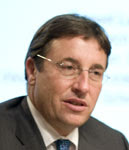 “Can we get beyond the point where environment and conflict always has to be a story of tragedy with no happy ending?” asked Achim Steiner at the March 24, 2009,
“Can we get beyond the point where environment and conflict always has to be a story of tragedy with no happy ending?” asked Achim Steiner at the March 24, 2009, 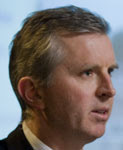
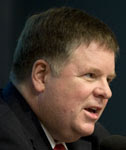 According to Reifsnyder, the U.S. government frequently supports UNEP initiatives, such as the $1.8 million in U.S. funding for a UNEP reforestation and energy-efficiency program in an internally displaced persons camp in Darfur. This project grew out of the
According to Reifsnyder, the U.S. government frequently supports UNEP initiatives, such as the $1.8 million in U.S. funding for a UNEP reforestation and energy-efficiency program in an internally displaced persons camp in Darfur. This project grew out of the  “If you want to bring about conservation of these big, iconic species that need lots of area to roam, you have to work with the people that are living there,” said Jon Miceler at a March 19, 2009, event, “
“If you want to bring about conservation of these big, iconic species that need lots of area to roam, you have to work with the people that are living there,” said Jon Miceler at a March 19, 2009, event, “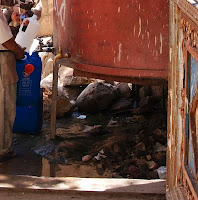 “Sana’a might very well become the
“Sana’a might very well become the  U.S. journalists “are by and large dying for the opportunity to go overseas and learn about a whole range of issues, from refugees to human rights,” but often lack the support of their editors—the “gatekeepers”—to do so, said Louise Lief, deputy director of the International Reporting Project (IRP), at a February 26, 2009, event, “
U.S. journalists “are by and large dying for the opportunity to go overseas and learn about a whole range of issues, from refugees to human rights,” but often lack the support of their editors—the “gatekeepers”—to do so, said Louise Lief, deputy director of the International Reporting Project (IRP), at a February 26, 2009, event, “
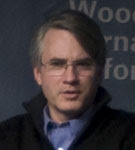 “In a developing country, what is it that moves people, that makes the economy grow?” BusinessWeek’s David Rocks wondered before visiting Uganda.
“In a developing country, what is it that moves people, that makes the economy grow?” BusinessWeek’s David Rocks wondered before visiting Uganda.
 “Water access is no longer simply a global health and development issue; it is a mortal and long-term threat that is increasingly becoming a
“Water access is no longer simply a global health and development issue; it is a mortal and long-term threat that is increasingly becoming a 

